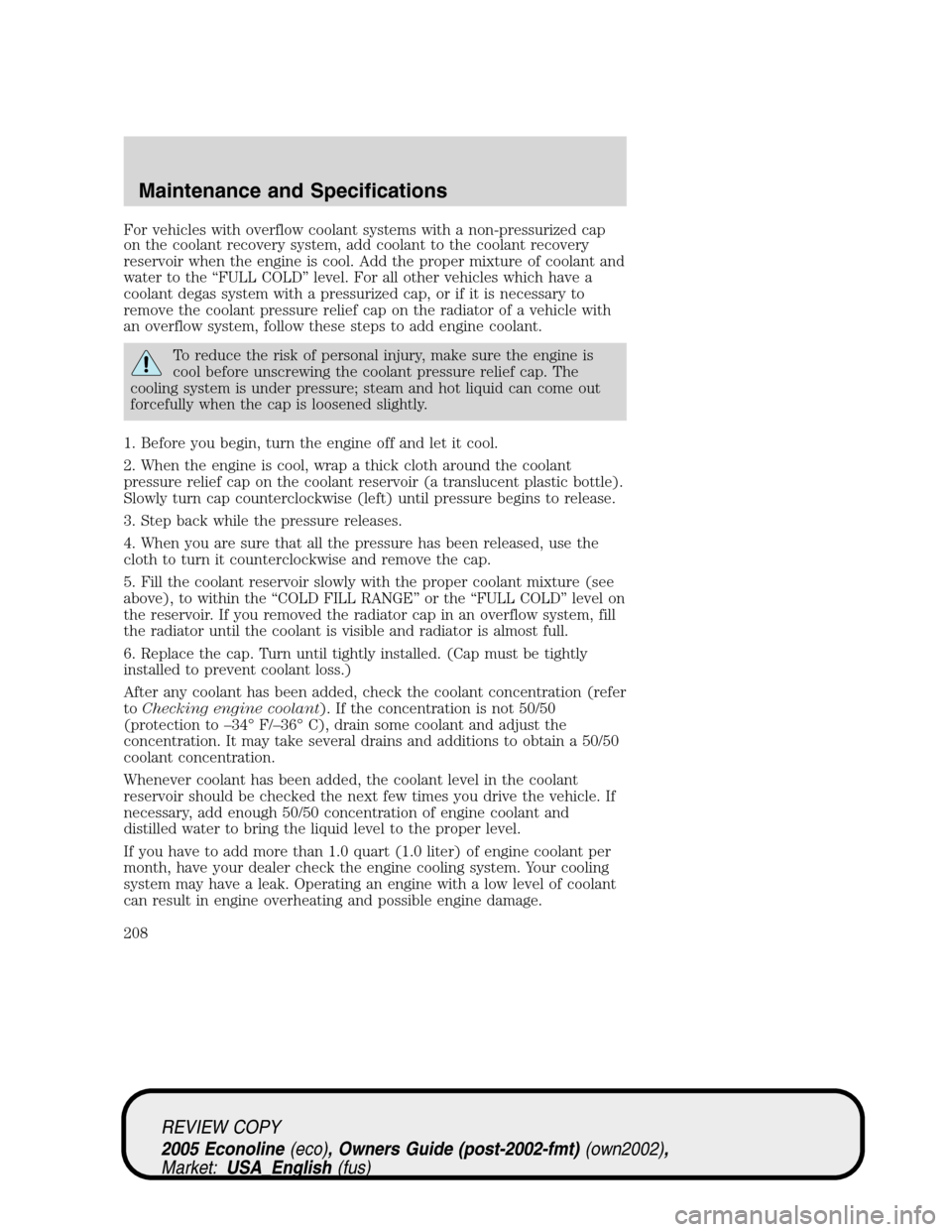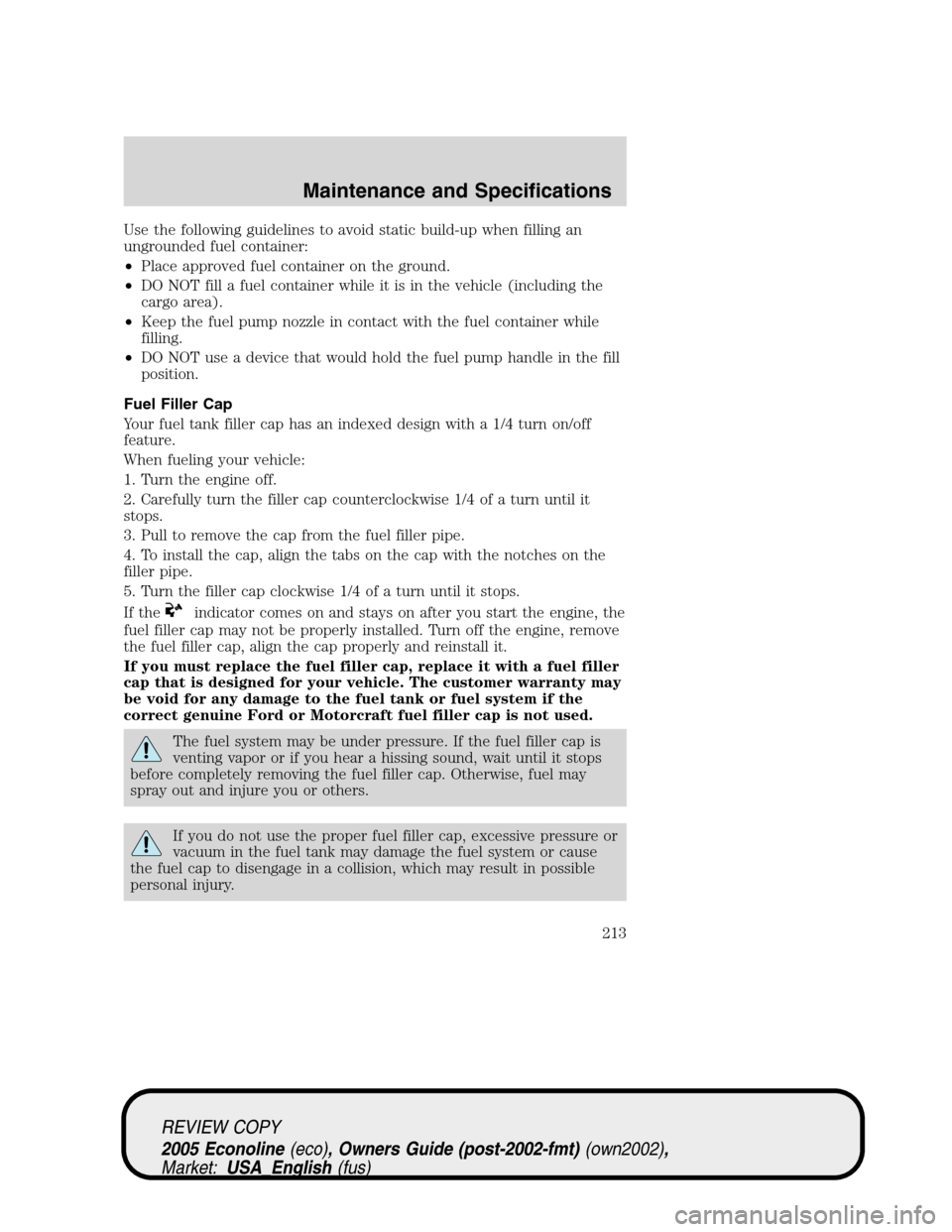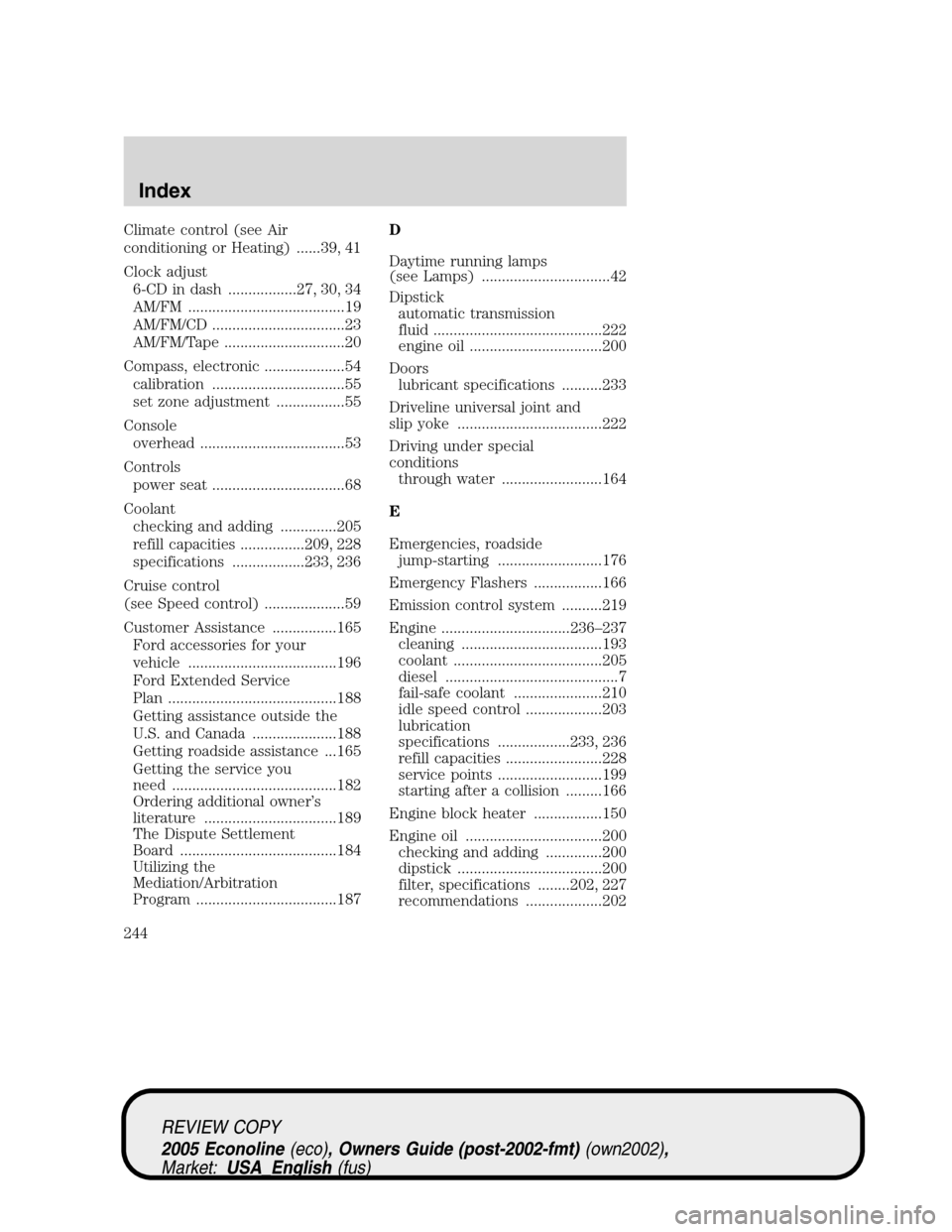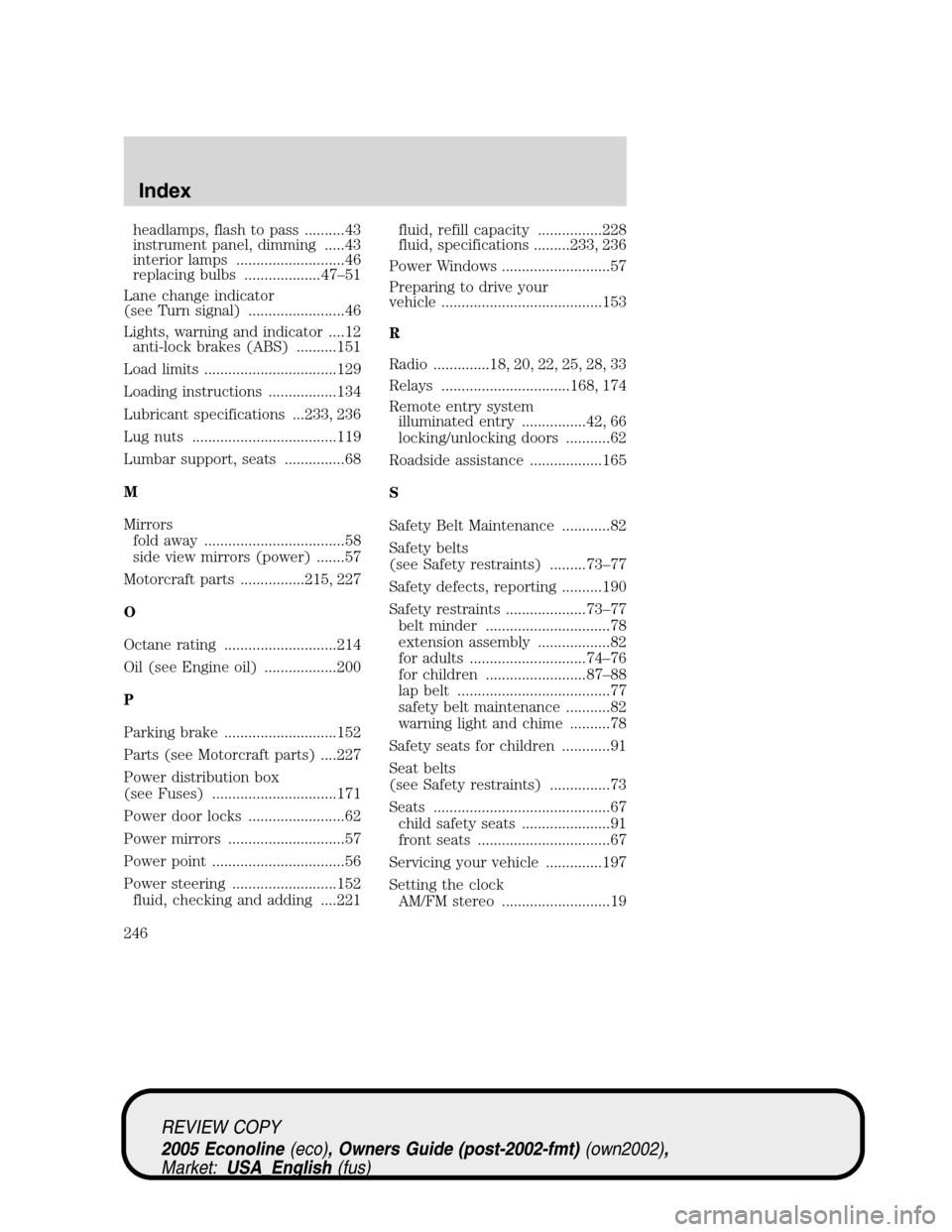clock FORD E SERIES 2005 4.G Owner's Manual
[x] Cancel search | Manufacturer: FORD, Model Year: 2005, Model line: E SERIES, Model: FORD E SERIES 2005 4.GPages: 248, PDF Size: 5.53 MB
Page 208 of 248

For vehicles with overflow coolant systems with a non-pressurized cap
on the coolant recovery system, add coolant to the coolant recovery
reservoir when the engine is cool. Add the proper mixture of coolant and
water to the “FULL COLD” level. For all other vehicles which have a
coolant degas system with a pressurized cap, or if it is necessary to
remove the coolant pressure relief cap on the radiator of a vehicle with
an overflow system, follow these steps to add engine coolant.
To reduce the risk of personal injury, make sure the engine is
cool before unscrewing the coolant pressure relief cap. The
cooling system is under pressure; steam and hot liquid can come out
forcefully when the cap is loosened slightly.
1. Before you begin, turn the engine off and let it cool.
2. When the engine is cool, wrap a thick cloth around the coolant
pressure relief cap on the coolant reservoir (a translucent plastic bottle).
Slowly turn cap counterclockwise (left) until pressure begins to release.
3. Step back while the pressure releases.
4. When you are sure that all the pressure has been released, use the
cloth to turn it counterclockwise and remove the cap.
5. Fill the coolant reservoir slowly with the proper coolant mixture (see
above), to within the “COLD FILL RANGE” or the “FULL COLD” level on
the reservoir. If you removed the radiator cap in an overflow system, fill
the radiator until the coolant is visible and radiator is almost full.
6. Replace the cap. Turn until tightly installed. (Cap must be tightly
installed to prevent coolant loss.)
After any coolant has been added, check the coolant concentration (refer
toChecking engine coolant). If the concentration is not 50/50
(protection to –34° F/–36° C), drain some coolant and adjust the
concentration. It may take several drains and additions to obtain a 50/50
coolant concentration.
Whenever coolant has been added, the coolant level in the coolant
reservoir should be checked the next few times you drive the vehicle. If
necessary, add enough 50/50 concentration of engine coolant and
distilled water to bring the liquid level to the proper level.
If you have to add more than 1.0 quart (1.0 liter) of engine coolant per
month, have your dealer check the engine cooling system. Your cooling
system may have a leak. Operating an engine with a low level of coolant
can result in engine overheating and possible engine damage.
REVIEW COPY
2005 Econoline(eco), Owners Guide (post-2002-fmt)(own2002),
Market:USA_English(fus)
Maintenance and Specifications
208
Page 213 of 248

Use the following guidelines to avoid static build-up when filling an
ungrounded fuel container:
•Place approved fuel container on the ground.
•DO NOT fill a fuel container while it is in the vehicle (including the
cargo area).
•Keep the fuel pump nozzle in contact with the fuel container while
filling.
•DO NOT use a device that would hold the fuel pump handle in the fill
position.
Fuel Filler Cap
Your fuel tank filler cap has an indexed design with a 1/4 turn on/off
feature.
When fueling your vehicle:
1. Turn the engine off.
2. Carefully turn the filler cap counterclockwise 1/4 of a turn until it
stops.
3. Pull to remove the cap from the fuel filler pipe.
4. To install the cap, align the tabs on the cap with the notches on the
filler pipe.
5. Turn the filler cap clockwise 1/4 of a turn until it stops.
If the
indicator comes on and stays on after you start the engine, the
fuel filler cap may not be properly installed. Turn off the engine, remove
the fuel filler cap, align the cap properly and reinstall it.
If you must replace the fuel filler cap, replace it with a fuel filler
cap that is designed for your vehicle. The customer warranty may
be void for any damage to the fuel tank or fuel system if the
correct genuine Ford or Motorcraft fuel filler cap is not used.
The fuel system may be under pressure. If the fuel filler cap is
venting vapor or if you hear a hissing sound, wait until it stops
before completely removing the fuel filler cap. Otherwise, fuel may
spray out and injure you or others.
If you do not use the proper fuel filler cap, excessive pressure or
vacuum in the fuel tank may damage the fuel system or cause
the fuel cap to disengage in a collision, which may result in possible
personal injury.
REVIEW COPY
2005 Econoline(eco), Owners Guide (post-2002-fmt)(own2002),
Market:USA_English(fus)
Maintenance and Specifications
213
Page 244 of 248

Climate control (see Air
conditioning or Heating) ......39, 41
Clock adjust
6-CD in dash .................27, 30, 34
AM/FM .......................................19
AM/FM/CD .................................23
AM/FM/Tape ..............................20
Compass, electronic ....................54
calibration .................................55
set zone adjustment .................55
Console
overhead ....................................53
Controls
power seat .................................68
Coolant
checking and adding ..............205
refill capacities ................209, 228
specifications ..................233, 236
Cruise control
(see Speed control) ....................59
Customer Assistance ................165
Ford accessories for your
vehicle .....................................196
Ford Extended Service
Plan ..........................................188
Getting assistance outside the
U.S. and Canada .....................188
Getting roadside assistance ...165
Getting the service you
need .........................................182
Ordering additional owner’s
literature .................................189
The Dispute Settlement
Board .......................................184
Utilizing the
Mediation/Arbitration
Program ...................................187D
Daytime running lamps
(see Lamps) ................................42
Dipstick
automatic transmission
fluid ..........................................222
engine oil .................................200
Doors
lubricant specifications ..........233
Driveline universal joint and
slip yoke ....................................222
Driving under special
conditions
through water .........................164
E
Emergencies, roadside
jump-starting ..........................176
Emergency Flashers .................166
Emission control system ..........219
Engine ................................236–237
cleaning ...................................193
coolant .....................................205
diesel ...........................................7
fail-safe coolant ......................210
idle speed control ...................203
lubrication
specifications ..................233, 236
refill capacities ........................228
service points ..........................199
starting after a collision .........166
Engine block heater .................150
Engine oil ..................................200
checking and adding ..............200
dipstick ....................................200
filter, specifications ........202, 227
recommendations ...................202
REVIEW COPY
2005 Econoline(eco), Owners Guide (post-2002-fmt)(own2002),
Market:USA_English(fus)
Index
244
Page 246 of 248

headlamps, flash to pass ..........43
instrument panel, dimming .....43
interior lamps ...........................46
replacing bulbs ...................47–51
Lane change indicator
(see Turn signal) ........................46
Lights, warning and indicator ....12
anti-lock brakes (ABS) ..........151
Load limits .................................129
Loading instructions .................134
Lubricant specifications ...233, 236
Lug nuts ....................................119
Lumbar support, seats ...............68
M
Mirrors
fold away ...................................58
side view mirrors (power) .......57
Motorcraft parts ................215, 227
O
Octane rating ............................214
Oil (see Engine oil) ..................200
P
Parking brake ............................152
Parts (see Motorcraft parts) ....227
Power distribution box
(see Fuses) ...............................171
Power door locks ........................62
Power mirrors .............................57
Power point .................................56
Power steering ..........................152
fluid, checking and adding ....221fluid, refill capacity ................228
fluid, specifications .........233, 236
Power Windows ...........................57
Preparing to drive your
vehicle ........................................153
R
Radio ..............18, 20, 22, 25, 28, 33
Relays ................................168, 174
Remote entry system
illuminated entry ................42, 66
locking/unlocking doors ...........62
Roadside assistance ..................165
S
Safety Belt Maintenance ............82
Safety belts
(see Safety restraints) .........73–77
Safety defects, reporting ..........190
Safety restraints ....................73–77
belt minder ...............................78
extension assembly ..................82
for adults .............................74–76
for children .........................87–88
lap belt ......................................77
safety belt maintenance ...........82
warning light and chime ..........78
Safety seats for children ............91
Seat belts
(see Safety restraints) ...............73
Seats ............................................67
child safety seats ......................91
front seats .................................67
Servicing your vehicle ..............197
Setting the clock
AM/FM stereo ...........................19
REVIEW COPY
2005 Econoline(eco), Owners Guide (post-2002-fmt)(own2002),
Market:USA_English(fus)
Index
246